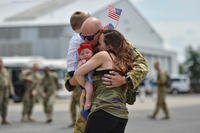The American Red Cross has been helping military families deal with the challenges of military life for more than 140 years. One of the ways the Red Cross helps military families specifically is through emergency communications, which they began facilitating in 1905.
In 2020, the Red Cross sent 344,000 emergency communications messages, said Yolanda Gainwell, a programs division director for the Red Cross. In addition, 200,000 critical community service cases were created, she said.
Gainwell said emergency communications messages deal with life expectancy, a birth, a death or an impending death.
"I would say the number one and number two [reasons] are death and illness," she said.
Critical community service cases are when a veteran -- retiree or not -- has an immediate urgent need. This could be food insecurity, pending homelessness or an extenuating medical circumstance, and the Red Cross connects them to another aid society or provides community referrals.
Why Send a Red Cross Message?
With social media and cell phones, it seems like sending a Red Cross message may not be important. However, Gainwell said it only makes them more important; in fact, they've seen an increase in the number of messages sent.
"We are congressionally chartered to provide emergency communication messages for all of our branches of services, 24 hours a day, seven days a week," she said. "The commands rely on us to verify every emergency that we get."
Army spouse Samantha Hamilton sent two emergency messages, both announcing the birth of a child. The first time, she sent one after an emergency cesarean section, and her husband, who was in the field, didn't get the message until three days later.
Hamilton said she learned how to send a message through a spouses' meeting where they made a deployment binder, which included the information about the Red Cross.
"The second time I sent it with my second child. It was much easier to get through and he was notified within the day to give me a call," Hamilton said. "It was much easier, because I was informed and prepared from the last time I did it."
How Do You Send an Emergency Message?
Gainwell says the most important thing military spouses and family members need to know about sending emergency messages through the Red Cross is that preparedness is key.
"Anyone with the pertinent information can initiate a Red Cross message," she said. "So that could be my neighbor. That could be my family member. That could be my girlfriend in another state that understands the situation and what's going on."
Gainwell suggests downloading the Hero Care app and loading in the key pieces of information, which includes the service member's first and last name; rank; the branch of service; the last four digits of their Social Security number, if you have it; the date of birth; and the military unit to which they're assigned. If the service member is deployed, include the rear-detachment contact information as well.
Gainwell also said that if you think something warrants an emergency message, contact the Red Cross, either online, on the phone or in person.
"If you ever have a question or a doubt in your mind, call us. If it is truly not an emergency, we will let you know," she said.
For those who don't want to use the app, emergency communications specialists are available 24/7 at 1-877-272-7337. Gainwell suggests putting the Red Cross information somewhere that a friend or family member could find easily, in case they need to make the phone call.
What Happens When You Contact the Red Cross?
After the information is received at the Hero Care Center, the verification process begins. This may mean contacting medical authorities, the funeral home or the police department. Gainwell says this is why providing as much information to the Red Cross is helpful, as it shortens the verification process timelines.
The goal is to get it verified as quickly as possible, but if key information -- such as the service member's unit -- is missing, it will take longer.
"We have access to DoD directories, where we can find that information, but that's going to take time. So the more information the client can share with us when they initially contact us, [the better]," Gainwell said.
Once the emergency message is verified, it is sent to the service member's command. Gainwell was very clear that any decision made after the message is sent is by the command. Sometimes that means nothing happens.
"Emergency leave, even with a Red Cross message, it's at the discretion of command," Gainwell said.
Keep Up with the Ins and Outs of Military Life
For the latest military news and tips on military family benefits and more, subscribe to Military.com and have the information you need delivered directly to your inbox.




























